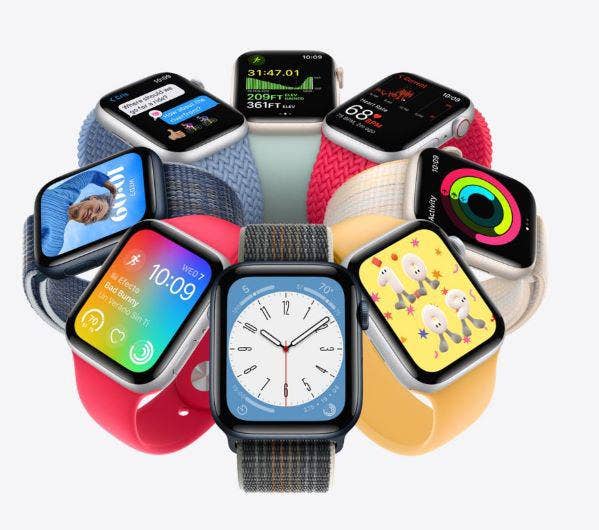Samsung, Apple Wearables Q2 Shipments Decline: IDC
Four of the top five wearable producers saw decreased shipments year-over-year. But the firm expects the wearables market to rebound, albeit at a slower pace.

While mobile titans Apple and Samsung both had major wearable release updates this year – declining shipments might take a bite out of sales for the wearable market overall (at least in the short term), according to research firm IDC.
The Needham, Mass.-based IDC said wearables were facing a tough second quarter of 2022 with global shipments declining 6.9 percent year over year to 107.4 million units. The group said rising inflation, fears surrounding recession, and increased spending on non-tech categories is putting a damper on the wearable tech market, which includes smartwatches, earbuds, and health trackers.
Four of the top five wearable producers experienced year-over-year declines during the second quarter and smaller brands are eating up more market share with a focus on lower price points, putting pressure on the top brands’ selling prices, IDC says. The top five brands include Apple, Samsung, Xiaomi, Huawei, and Imagine Marketing).
“It’s unfortunate that companies like Apple, Samsung, and Google are in the midst of launching more premium smartwatches at a time when appetite for high priced products remains in question,” Jitesh Ubrani, research manager for IDC’s mobility and consumer device trackers, said in a release. “And even though pricing on some new products remains the same as the previous generation, the strength of the U.S. dollar makes the purchase more difficult in local currencies around the world.”
This month, Apple launched its new Apple Watch Series 8 and added the rugged Apple Watch Ultra, which boasts increased water resistance and up to 60 hours of battery life at a price of $799. The company hedged with an affordable new Apple Watch SE option starting at $249. Samsung’s flagship Galaxy Watch 5 and 5 Pro got upgrades in August with options starting at $280.
IDC says rising prices and a demand slowdown have lowered the overall outlook for wearables. The firm now forecasts shipments for the full year of 2022 to remain flat at 535.5 million units. The silver lining, IDC says, is that growth will rebound in 2023 as demand for watches and hearables is expected to rebound with new customers in emerging markets and replacement demand in mature markets.
“While wearables market was down in the second quarter and will most likely be flat this year, it is certainly not out,” Ramon T. Llamas, research director for mobile devices at IDC, said in a release. “As the wearables market takes slow steps toward maturity, it will eventually reckon the ebbs and flows between the record-breaking volumes we saw during the pandemic and what we see today.”
Llamas added, “But overall, the trend continues upwards, just at a slower pace as consumers seek replacements and the number of new users starts to decline.”
Andreea Danielescu, Accenture’s director for future technologies research and development, told CRN in an email that despite the recent shipment decline, the future for wearables in the business sector is still promising.
“Looking ahead, I anticipate several advances within the wearables market… in time we’ll see flexible electronics marry with textiles and even the energy harvesting and storage technologies to create a number of opportunities for e-textile applications. These could of course be used for consumer electronics… but they’ll also have a huge impact in healthcare more broadly, in remote worker monitoring and increased situational awareness among first responders, among other applications… we can expect these technologies to improve upon existing uses for wearables and create entirely new ones,” she wrote.
Apple remained the leader in wearables with 25 percent market share, though the Cupertino, Calif. company saw a 16 percent decline in the second quarter. New York City-based research firm Market Research Future projects the healthy long-term growth for the wearables market, estimating $410.2 billion in global revenue by 2030 – that’s a compound annual growth rate (CAGR) of 31 percent. The company attributes the demand to the increase in chronic diseases and obesity – which will create more interest in wearables’ health tracking features.